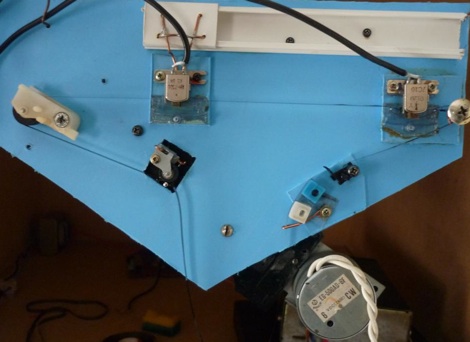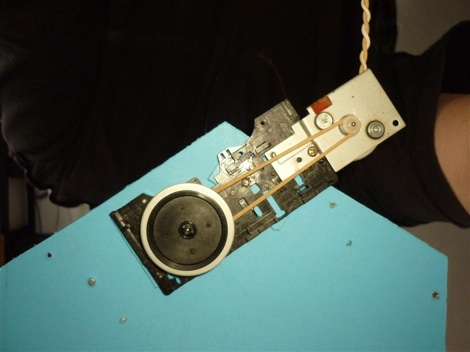
Professional tape delay units are great fun, but often expensive. You’d think that with so many derelict cassette decks filling the world’s dumpsters someone must have figured out a way to make a cheap tape delay… not only in the interest of saving money (sometimes quality is worth paying for) but also in the interest of re-using otherwise wasted resources.
Forosdeelectronica forum user [Dano] has made just such a device from used cassette decks and miscellaneous parts (translated). First he investigated the operation of the playback, erase, and record mechanisms and broke out the tape heads. The playback head is on a plastic rail so that the delay time can be changed, while the record head is fixed. [Dano] encountered some difficulties in ensuring good quality for the recording and erasure, which is an important consideration when working with magnetic tape.

Another fun aspect of this project is the modded drive speed, which would allow for some wacky time/pitch stretching.

You can listen to the audio example of the working system here.
We don’t know about you, but we have several old tape cassettes sitting in our “to-hack” box and they’re not exactly hard to find elsewhere–many of them end up on the curb on garbage day. It would be fun to combine this with other audio projects like Rich Decibel’s Kequencer–think of matching the delay length to the sequenced pattern length! For a more finicky addition you could play around with the drive mechanism using some custom gearing–think multiple loops and reversals.
The images in this post are taken for illustrative purposes from Forosdeelectronica.com. If you want to see them in [Dano]’s post you must register on their forums.














Not sure about the time/pitch stretching; that would require the tape moving at different speeds past the record and play heads…not possible with a single loop of tape. Changing the motor speed shouldn’t have any effect on the overall output, other than possible sound quality issues.
Hey guys, look up echoplex, a good example we used for vocal and instruments in the good ole’ days!
The post this links to is dated 2006…
However, it’s still a pretty cool hack and the first time I’ve seen it
i’m still working on this but i’ve made a tape delay from a floppy drive
it’s fun to play around with the platter cause you can ‘scratch’ what you’ve just played
http://www.youtube.com/watch?v=tAEmo7Ycd1Q
Finding this idea about 9 years later still makes me wonder why I never thought of this. Thanks for sharing!
Jeri doing it ten years ago: https://hackaday.com/2009/04/24/analog-audio-recorded-on-a-floppy/
@zool:
Your floppy drive delay is freakin’ sweet. PLEASE send in a DIY because I want to make one. How long of a delay can you get with that?
Nice hack.
@Zool
I’d be interested in seeing the details of your hack. You ought to do a write up and submit it to Hack-a-Day
@Lenny
what does date matter?
This is exaclty how the first musical delays were made. Look for the Watkins Copicat.
@ridefst Changing the speed of the tape would alter the timing of the delay effect, as it takes the tape more/less time for the part of the tape to get from the record head to the play head dependent on speed. The pitch would also change relative to the tape speed, but only if you’re actively changing the speed as the sound’s being recorded and played back. It creates some wicked sounds.
As you point out, tape speed does effect sound quality, although I can imagine slow speeds would give some nice grundgy sounds.
TBH I think altering the speed of the tape is a better approach to altering the delay time than physically altering the distance between the heads.
@Lenny No its not, Thats the date Dano joined. It was posted 1 day ago.
And props to dano for this build. amazing.
Some more floppy drive delay/reverb,
http://hackaday.com/2009/04/24/analog-audio-recorded-on-a-floppy/
While this is a pretty cool hack it should not be confused with workable schemes. You could get a much better (as in less noisy and more reliable) effect with any of a dozen cheap microcontrollers and no moving parts.
Back in the early 80’s, I was involved in doing this to produce a phone-in talk radio show at a college radio station (with no budget for real delay equipment). We recorded phones & studio mikes on one open-reel deck, ran the tape over a couple of pulleys and played back on another deck to go on the air. The tricky parts were cueing the talent to start talking 7 seconds early, and quickly rethreading the machines when the tape ran out or broke. Good times!
looks like the forum is trying to recruit more users by having a signup to look at content.
@localroger: Sure, or you could buy a digital delay pedal. But that’s not the point is it? Analog (and specifically tape-based) delays have certain characteristics that are actually desirable to musicians. A more “workable scheme” could also be a reel-to-reel tape recorder which would offer better overall fidelity and stability plus a better platform to build on. Downside – larger size in many cases and more expensive to begin with.
I could not see the images so I assume the project works only as a tape delay, therefore the following could be of interest.
A tape delay can be turned into a chorus machine by putting the two (or more) tape heads relatively closer then slowly moving the playing one(s) back and forth in order to change the distance between the recording head and the playing one(s). This what the modulation control does in electronic chorus effects (digital or analog) and slowly changes the played signal frequency so that it creates the chorus effect once it’s mixed back with the original one.
To easily and slowly move the head(s) a servo could be used but beware of microphonicity if the tape head catches the servo vibrations.
BTW, I hate sites that force you to sign up only to see images, they clearly don’t realize what means trying to remember a user login+password for every site where something interesting is posted.
Can’t see the images?
Wow, retro…. how does Hack A Day look in Lynx anyhow?
BTW, I’m not a registered user and I see the images and can post just fine.
http://www.mzentertainment.com/studio_workshop_zdlctd105.html
I found this guy’s project years ago, and I did a very similar delay unit with two identical desktop recorders strung together using a custom cartridge with two cassettes wound with one tape to provide the delay.
instead of harvesting tape decks, you could get those old tape adapters we used for our cars in the days before digital playback was available for Car head units.
I did the same thing in the ’70’s with 3 heads an a a schematic for an input mixer I found in on of Mimms’ books.
It worked out fairly well and was quite entertaining during “festive occasions”.
Three head tape decks from the old days had this feature and the delay was very short. If this unit has a short delay, here’s something that will reduce most people to tears of laughter. Wear headphones and speak into a microphone. You hear what you read a small fraction of a second later and it is impossible to continue until you learn to ignore the sound of your own voice.
Ha, ha, ha, this is the bane of all new broadcasters when they forget to switch their headset monitor back to “studio-feed” instead of “off-air”.
This is a fun little project that could be very useful in some situations, although the lack of capstans for the tape heads really limits the signal being recorded, as the tape to head distance will be continuously variable, and wow-and -flutter must be off the charts, but if those things don’t matter to the music/audio project being recorded, who cares, eh?
Years before digital recording made it’s way into radio stations I helped a buddy record a spot for his radio show and he wanted a custom music bed, so I wound up standing 10 feet away from the reel-to-reel tape deck, holding a pencil in the end of the loooong loop of tape. It worked, but it was certainly unconventional.